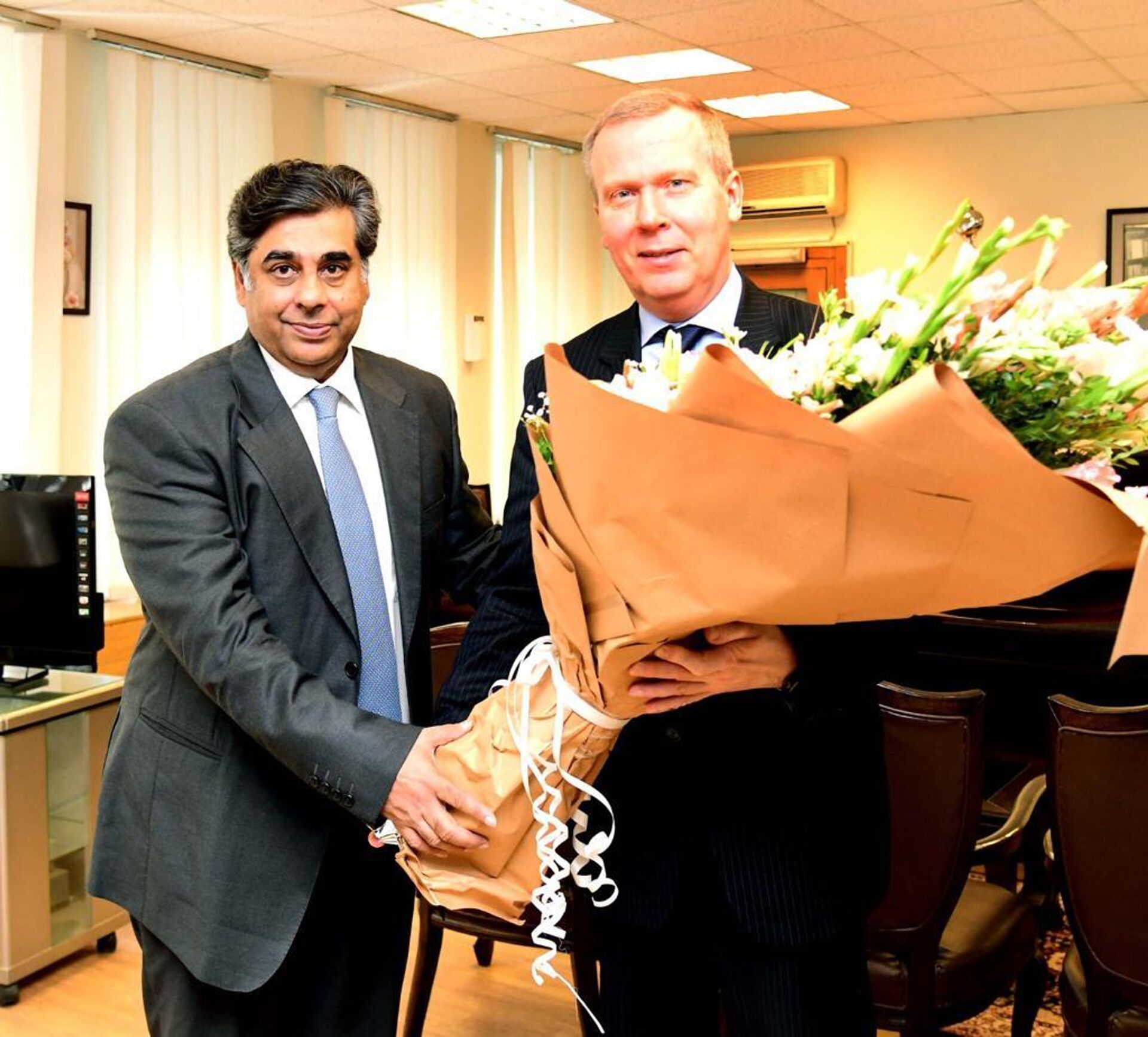https://sputniknews.in/20231013/chinese-yuan-could-be-preferred-currency-for-russia-pakistan-oil-trade-expert-4808965.html
Chinese Yuan Could be Preferred Currency for Russia-Pakistan Oil Trade: Expert
Chinese Yuan Could be Preferred Currency for Russia-Pakistan Oil Trade: Expert
Sputnik India
As Pakistan looks to expand its energy trade with Russia, trading in Chinese yuan could be a lucrative proposition to bypass western sanctions and save costs, experts believe.
2023-10-13T20:09+0530
2023-10-13T20:09+0530
2023-10-13T20:09+0530
sputnik opinion
pakistan
russia
vladimir putin
us
european union (eu)
russian energy week
global oil production
oil exporters
russian oil price cap
https://cdn1.img.sputniknews.in/img/07e7/04/02/1402559_0:0:2974:1674_1920x0_80_0_0_44396bf18e9ee03cd7114402cbed93bf.jpg
The Chinese yuan renminbi (RMB) is best-placed become the preferred currency in the energy trade transactions between Pakistan and Russia, an Indian think tanker has told Sputnik India.Seshadri Vasan, the Director-General of Chennai Centre for China Studies (C3S), highlighted that Beijing has already been investing in the Belt and Road Initiative (BRI) projects through its domestic currency.The China-watcher noted that Beijing would like to further its “strategic leverage” over Pakistan by pushing for trade settlements between Pakistan and its other foreign partners in RMB.Pakistan has been a major beneficiary of Beijing’s global connectivity initiative through the China-Pakistan Economic Corridor (CPEC), which is described as the flagship project of the BRI.China is also Pakistan’s biggest trading partner and the biggest source of imports, according to official data cited in Chinese state media.Vasan also noted that a significant amount of trade between Russia and China was already being carried out in RMB, which makes it more likely for the three nations to reach some arrangement on Russia-Pakistan crude trade.Russian President Vladimir Putin told the Eastern Economic Forum (EEF) in Vladivostok last month than over 80 percent of bilateral trade between China and Russia, which is expected to hit an all-time high of $200 billion this year, was taking place in local currencies.Pakistan received its first shipments of Russian crude in June this year, for which it reportedly paid in RMB. Pakistan received its second shipment of seaborne crude from Russia of 100,000 metric tonnes this month.Why Pakistan Doesn’t Want to Pay in US Dollars?Beijing has also rolled over $5 billion worth of loans it owed to Pakistan in recent months as Islamabad struggles to pay back its foreign debt amid dwindling foreign exchange reserves.The State Bank of Pakistan (SBP) has said that Pakistan’s forex reserves stood at just over $7 billion in the week ending 6 October.High fuel and food prices in the wake of Covid pandemic and western sanctions against Russia over its Special Military Operation significantly affected import bills of Pakistan, precipitating the economic crisis.Vasan said that Pakistan’s economic situation is a major factor which is driving it away from the US dollar.The think-tanker said that as far as Russia is concerned, it was looking for new markets for its energy exports to replace European Union (EU), which was the biggest importer of Russian oil till February last year.Since last year, China and India have emerged as the biggest importers of Russian oil, a trend analysts say will continue due to huge demand for energy in the world’s fastest-growing economies.Pakistan's Intention is a Part of De-dollarization Trend: EconomistIndian economist and Delhi University professor Ashwani Mahajan explained that Islamabad’s proposal to move away from the US dollar in the energy trade with Russia was part of broader global trend of de-dollarization.Mahajan said that volatility in global exchange rate of US dollar vis-à-vis other currencies has made it unreliable for other nations.Mahajan also noted that trading in a non-US dollar currency could help countries like Pakistan to dodge western sanctions against Russia.
https://sputniknews.in/20230822/ditching-the-petrodollar-will-benefit-global-south-expert-reckons-3764196.html
pakistan
russia
us
india
china
Sputnik India
feedback.hindi@sputniknews.com
+74956456601
MIA „Rossiya Segodnya“
2023
Dhairya Maheshwari
https://cdn1.img.sputniknews.in/img/07e6/0c/13/138962_0:0:641:640_100x100_80_0_0_2cb44360dbcdf6d84bf4b299cd045917.jpg
Dhairya Maheshwari
https://cdn1.img.sputniknews.in/img/07e6/0c/13/138962_0:0:641:640_100x100_80_0_0_2cb44360dbcdf6d84bf4b299cd045917.jpg
News
en_IN
Sputnik India
feedback.hindi@sputniknews.com
+74956456601
MIA „Rossiya Segodnya“
Sputnik India
feedback.hindi@sputniknews.com
+74956456601
MIA „Rossiya Segodnya“
Dhairya Maheshwari
https://cdn1.img.sputniknews.in/img/07e6/0c/13/138962_0:0:641:640_100x100_80_0_0_2cb44360dbcdf6d84bf4b299cd045917.jpg
russia pakistan oil trade, chinese yuan renminbi, rmb, chinese yuan, energy trade, energy trade with russia, western sanctions, dedollarization, russia pakistan ties, russia pakistan relations, russia pakistan trade, russia pakistan cooperation, why pakistan doesn’t want to pay in us dollars,
russia pakistan oil trade, chinese yuan renminbi, rmb, chinese yuan, energy trade, energy trade with russia, western sanctions, dedollarization, russia pakistan ties, russia pakistan relations, russia pakistan trade, russia pakistan cooperation, why pakistan doesn’t want to pay in us dollars,
Chinese Yuan Could be Preferred Currency for Russia-Pakistan Oil Trade: Expert
As Pakistan looks to expand its energy trade with Russia, trading in Chinese yuan could be a lucrative proposition to bypass western sanctions and save costs, experts believe.
The Chinese yuan renminbi (RMB) is best-placed become the preferred currency in the energy trade transactions between Pakistan and Russia, an Indian think tanker has told Sputnik India.
Seshadri Vasan, the Director-General of Chennai Centre for China Studies (C3S), highlighted that Beijing has already been investing in the Belt and Road Initiative (BRI) projects through its domestic currency.
“Chinese government and companies have already invested billions of RMB in Pakistan’s connectivity, industrial and power infrastructure under the CPEC over the last decade,” Vasan stated.
The China-watcher noted that Beijing would like to further its “strategic leverage” over Pakistan by pushing for trade settlements between Pakistan and its other foreign partners in RMB.
Pakistan has been a major beneficiary of Beijing’s global connectivity initiative through the China-Pakistan Economic Corridor (CPEC), which is described as the flagship project of the BRI.
China is also Pakistan’s biggest
trading partner and the biggest source of imports, according to official data cited in Chinese state media.
Vasan also noted that a significant amount of trade between Russia and China was already being carried out in RMB, which makes it more likely for the three nations to reach some arrangement on Russia-Pakistan crude trade.
Russian President Vladimir Putin told the Eastern Economic Forum (EEF) in Vladivostok last month than over 80 percent of bilateral trade between China and Russia, which is expected to hit an all-time high of $200 billion this year, was taking place in local currencies.
The comments come against the backdrop of Pakistan Energy Minister telling the ongoing Russian Energy Week that payments for Russian crude exports to Pakistan weren’t likely to be made in US dollars.
Pakistan received its
first shipments of Russian crude in June this year, for which it reportedly paid in RMB. Pakistan received its second shipment of seaborne crude from Russia of 100,000 metric tonnes this month.
Why Pakistan Doesn’t Want to Pay in US Dollars?
Beijing has also rolled over $5 billion worth of loans it owed to Pakistan in recent months as Islamabad
struggles to pay back its foreign debt amid dwindling foreign exchange reserves.
The State Bank of Pakistan (SBP) has said that Pakistan’s forex reserves stood at just over $7 billion in the week ending 6 October.
High fuel and food prices in the wake of Covid pandemic and western sanctions against Russia over its Special Military Operation significantly affected
import bills of Pakistan, precipitating the economic crisis.
Vasan said that Pakistan’s economic situation is a major factor which is driving it away from the US dollar.
“Every country wants to take advantage of the current global crisis in getting the best deal, including Pakistan,” said Vasan.
The think-tanker said that as far as Russia is concerned, it was looking for new markets for its energy exports to replace European Union (EU), which was the biggest importer of Russian oil till February last year.
Since last year, China and India have emerged as the biggest importers of
Russian oil, a trend analysts say will continue due to huge demand for energy in the world’s fastest-growing economies.
Pakistan's Intention is a Part of De-dollarization Trend: Economist
Indian economist and Delhi University professor Ashwani Mahajan explained that Islamabad’s proposal to move away from the US dollar in the energy trade with Russia was part of broader global trend of de-dollarization.
“As Pakistan copes with a dire economic condition amid a balance of payments crisis and shortage of forex reserves, it is natural for it to look for alternatives to US dollar in trade with other nations,” stated Mahajan.
Mahajan said that volatility in global exchange rate of US dollar vis-à-vis other currencies has made it unreliable for other nations.
“The US dollar has been strengthening vis-à-vis other currencies, which adds to the transaction costs,” the Indian academic said.
Mahajan also noted that trading in a
non-US dollar currency could help countries like Pakistan to dodge western sanctions against Russia.




